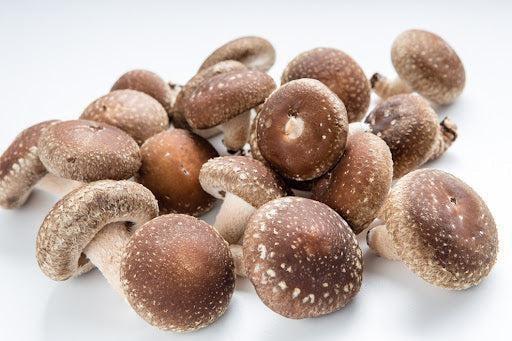
Jump to:
We’ve introduced some basic features of kinoko mushrooms in this article, with a brief information on those well-appreciated in Japan. Among these mushrooms, it’s a shiitake that is regarded as standard of the standards in Japanese cuisine. Shiitake is a miracle food that’s not only tasty but also healthy and can be used as a great dashi (soup stock) safe to vegetarians.

In this article we’ll take a further look on shiitake, the most popular mushroom in Japan. Whether or not you’re the beginner in Japanese kinokos, learning shiitake further may broaden your horizon in enjoying Japanese cuisines to the fullest. This article consists of:
- The basic information of shiitake
- The taste and umami of shiitake
- How to choose and store shiitake
- Health benefits of shiitake
- How shiitake is used in Japanese cuisine
- The shiitake-related products available at our stores
Shiitake: what you need to know
Shiitake can be translated as "shii mushroom". It was literally found in a shii tree, one of the hardwood trees similar to oak. Shiitake’s appearance features a round and large umbrella-like cap that has light brown or brown color, and a stem is usually white or cream colored and short in length. Shiitake is marketed in either raw or dried, and each have its own flavor and roles.
Shiitake mushroom has earthy taste and meaty texture distinctively different from other mushrooms. Shiitake is actually a versatile mushroom that can be used in any cooking method, but baking, stir-frying, and sautéing are considered to be the major ways to enjoy its flavor.


Traditionally, shiitake was produced through a log cultivation in Japan, but when a mushroom bed cultivation got introduced, this became the common production method. Almost all shiitakes available at the supermarkets are those produced in mushroom bed cultivation with affordable price and year-round availability.
On the other hand, the log-grown shiitake is actually an organic mushroom because it’s grown up without human intervention, resulting in richer umami and stronger aroma. However, since log cultivated shiitake can harvest only 1~2 time per year, it’s pricier and has less purchasing channels than the mushroom bed shiitake.
The taste of shiitake: from flavor to umami
Raw shiitake mushroom has earthy, buttery, and meaty flavor which is partly similar to a porcini mushroom. In contrast, dried shiitake has smoky flavor and said to have more intense tastes than the fresh counterpart. The texture of shiitake is also unique that it’s usually described as soft, chewy, and velvety featuring with lovely juiciness when cooked. Shiitake can be consumed as a delicacy to enjoy its rich taste and aroma, and its meat-like taste and texture makes a perfect replacement for meat in vegetarian recipes.

What make shiitake tasty is umami: one of the five taste sensations other than sweet, sour, bitter, and salty. Shiitake’s umami derives from an amino acid called guanylate, which is one of the three great umami nutrients, and it’s said that shiitake is one of the very few foods rich in guanylate. When this kinoko is cooked with other ingredients, this umami acid helps enhancing the foods’ umami, thus it makes the taste richer. Further, guanylate gets stronger when it is dried, meaning that dried shiitake has more umami than the raw one.
Tips for choosing good shiitake and storing it
Let’s begin with how to choose raw shiitake. Fresh raw shiitake generally has a round and plump cap that curls downward while the stem thick and short, and the gills (radiating plates on the undersurface of the cap) are white with few dirt on it. Raw shiitake doesn’t last long, so it’s recommended to consume as soon as possible or cook it soon after purchase. If you wish to store raw shiitake, wrap it with a wet paper towel and refrigerate it so that it can last up to 1~2 weeks.


There’re three points to choose quality dried shiitake. First, avoid pre-sliced shiitake as this is often said to be inferior in quality. Second, just like the raw shiitake, the thick cap and skinny stem are the signs of quality dried shiitake. Third, although it tends to be more expensive, the dried shiitake that has a cracked cap, whose pattern resembles to a turtle shell, is greater in quality. As for the storing, put shiitake into a Ziploc bag and store it in a freezer so that it can last for roughly a month. The flavor hardly deteriorates even if it’s frozen; it rather becomes more flavorful thanks to the power of enzyme.
Shiitake health benefits
Shiitake contains considerable amount of dietary fiber, vitamin B, vitamin D, and minerals including potassium, phosphorus, copper, and selenium. Several research reveal that by regularly having this kinoko, it supports decreasing the cholesterol, bolsters resistance to virus diseases, enhances your immune system, and helps preventing risks of cancer.
One thing that’s noticeable in shiitake is if they’re dried, its nutrition and umami increase significantly. For instance, the raw mushroom bed cultivated shiitake has 4.2g of fiber and 0.4㎍ of vitamin D while the dried shiitake has 41.0g of fiber and 12.7㎍ of vitamin D (both per 100g). Although most shiitake mushrooms available at the stores are sold in the raw, you can make a homemade dry shiitake from these by exposing them to the sunlight for 1~2 day(s).
Shiitake in Japanese dishes
You can enjoy shiitake in any cooking method, but the best ways to enjoy shiitake differ between raw and dried. Fresh shiitake goes very well when used for grilled, sautéed, stir-fried, or deep fried while dried shiitake are often cooked for simmered or boiled dishes otherwise used as a soup or dashi source. Indeed, you can find shiitake in many major Japanese dishes: sukiyaki, udon, nimono (simmered dish seasoned with soy sauce, sugar, dashi, etc.), takikomi-gohan (Japanese mixed rice), and more.

The cap part is used for cooking regardless of raw and dry and stem is usually removed if it’s too tough, but stem is edible if it’s soft and even if it’s tough you can use it for dashi extraction. To prevent food waste and fully enjoy shiitake to its full potential, this is worth trying.
Here’s one typical but easy-to-make Japanese dish using shiitake called shiitake-no-amakarani (salty-sweet simmered shiitake). First, take the stem off but it's okay to keep it if the texture isn't tough. Meanwhile, mix 100ml (≒3.4 us fl oz) of water with a tablespoonful of sugar, soy sauce, sake (you can replace this with a white wine), mirin (sweet cooking sake), and an appropriate amount of powdered dashi into the pot. Then put the shiitake into this mixed soup and simmer it for 5~6 minutes on medium heat. After this, flip the shiitake and keep simmering until all the seasoning soup is gone. Cooking with sliced carrot, burdock, and bite-sized chicken makes this dish tastier.

Our Shiitake Products
In Japanese Taste, there’re several shiitake-related products available online. We can offer you some opportunities to have one of the commonly consumed kinokos in Japan at your home. Take a look at the following products and don’t hesitate to add it into your shopping cart once you have an interest.
1. Sugimoto Organic Japanese Dried Shiitake Mushrooms 70g
Sugimoto is one of the shiitake producers noted for quality shiitake products located in Miyazaki Prefecture. Their office is located in a town called Takachiho where is famous for its nature-rich geography ideal for growing shiitake. Indeed, Sugimoto’s shiitake are cultivated outdoors on the sawtooth oaks, and their tree sap nurtures the kinoko. This product is organically produced without pesticide.
When consuming dried shiitake, you need to rehydrate it by soaking the kinoko into water. Simply put the shiitake into a bowl of water for a day and it’s ready to eat. You can cut, slice, or dice to make it easier to eat, then cook it as you like. Don’t waste the water used for rehydration because it can be reused as a soup rich in dashi!

2. Sugimoto All-Purpose Japanese Shiitake Mushroom Powder 40g
This is another product from Sugimoto. It’s a powdered shiitake which enables you to enhance the taste of the dishes by just flaking this powder. As mentioned, shiitake has the amino acid that helps boosting the umami without increasing your daily salt intake. This is a miracle powder useful in enriching the taste and achieving healthy salt-free diet.
Although you can increase umami by simply flaking this powder to any dish, you can further enhance the umami by wetting the powder in advance. To do so, mix a tablespoon of the powder with 2 tablespoons of water and let it soak for approximately 10 minutes. Enjoy the benefits of a genuine shiitake mushroom.

3. Gyokuroen Shiitake Mushroom Tea 2g × 34 Sachets
In this article, you’ve learned that shiitake is one of the edible mushrooms and can be used as a good source of dashi, but did you know that shiitake is also drinkable? Yes, there’s a tea made from shiitake and here’s what our shop offers. Shiitake is granulated, seasoned with sugar and salt to adjust the taste. Simply-to-use instant tea that you can readily have this drink by dissolving the powder into a hot water, just like when you’re having a black tea or green tea.
This product is originally designed to drink as the tea, but can be used as a seasoning to enrich the taste and umami of the dishes. For instance, you can use this product in onion soup, scrambled eggs, baked potato, or pasta sauce. Add to anything you like, and you’ll experience the blast of shiitake aroma. We also offer this shiitake tea powder in resealable 60g bag.



0 comments